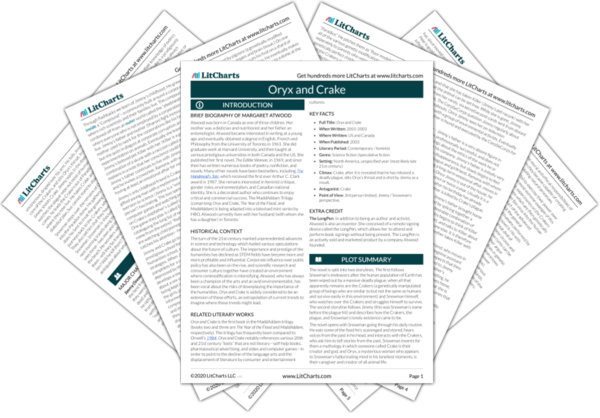Summary
Analysis
Mango. Snowman wakes up before sunrise. He is in a tree. He looks out through the thick green vegetation toward the ocean, and the nearby reef made of rusted car parts. He checks his watch, though it no longer works. He is horrified, for a moment, at the thought that no one anywhere knows the time. He calms himself and climbs carefully down from the tree, keeping an eye out for any signs of wildlife.
He goes to the bathroom in a bush, warning the grasshoppers (as he always does) to look out. He goes to a makeshift storage unit made out of old slabs on concrete and pulls out a mango—his last one. A phrase about the importance of routine comes into his head. He wonders where it came from—either a book or someone he used to know. He tries for a moment to remember other things from his past, his schooling, his childhood. He is unsuccessful and sits down to eat his mango.
The emphasis on Snowman’s routine tells us that he has been here for a long time. This also introduces the existence of disembodied voices in his head. His struggle to remember the source of these phrases emphasizes his alienation from the past and in fact from his very own mind. Though Snowman’s routine is consistent, his mind is fractured and chaotic.
Themes
Flotsam. A group of “the children” walk across the white beach toward Snowman. They are picking up flotsam and putting it in an old burlap sack. They notice Snowman and chant his name (“Snowman oh Snowman”) as they come toward him. Snowman cannot go out into the sun because it will burn him too badly, but these children have skin resistant to ultraviolet light.
We learn that Snowman has companions, but that they are fundamentally different to him. They are better adapted. They demonstrate evolutionary advantages over Snowman, who cannot even tolerate the light of the sun. Their chant as they approach him gestures to a kind of ritualistic appreciation of Snowman,
Themes
The children open up their sack so they can show the objects inside to Snowman. They hold up various objects: a hubcap, a piano key, an empty “BlyssPluss” container and an empty “ChickieNobs Bucket O’Nubbins.” Snowman explains that these are things from before. When asked if they are dangerous, Snowman says they are safe.
Snowman is revealed to be a kind of keeper of knowledge whom the “children” trust. Notably, the BlyssPluss that Snowman dubs “safe” will be revealed to have caused the death of most of humanity. It is no longer dangerous only because it is empty and has already taken its victims.
Themes
Get the entire Oryx and Crake LitChart as a printable PDF.

The children lose interest in the contents of their bag and linger around chanting Snowman’s name. Snowman thinks about how the children have never seen snow. He recalls that Crake did not allow any magical or fantastical names—and gets a bitter pleasure out of the thought that he has named himself after the Abominable Snowman.
We are introduced to the mysterious title character, Crake, and begin to see that he rejected fantasy, myth, and legend. Snowman’s anger and rebellion is demonstrated by his choice of name, which contains a referent to a long gone past (snow), a legendary or mythological creature, and also a kind of self-abnegation as “snowman” sounds a lot like “no man.”
Themes
Snowman knows the children want to hear stories about the past. He bitterly notes how beautiful they are—they demonstrate Crake’s aesthetic. They ask Snowman about the moss growing from his face. Snowman tells them—as he has told them many times before—that his face has feathers, but that they cannot have feathers. When they ask why, Snowman pretends to speak to Crake through his watch. He confirms that Crake says no feathers allowed, and tells the children to leave him alone.
We learn that the children were apparently designed or built by Crake. Their biological difference from Snowman is again emphasized—they do not understand facial hair. We also see that Snowman has made Crake into a kind of ruler or god, and has faked being in communication with him.
Themes
Voice. Left alone, Snowman hears a variety of voices in his head. One is woman, who compliments Snowman’s physique even though he is slowly starving to death. Snowman sadly notes that the woman is not Oryx, and that Oryx rarely talks to him anymore. He thinks the voice is of a prostitute he once purchased.
Snowman’s loneliness is emphasized. He is able to conjure up the voice of a prostitute, but not of Oryx, a woman he clearly cares deeply about. The suggestion is that he is losing touch with his memories of meaningful relationships, and what’s left is false affection.
Themes
Snowman worries about his rapidly declining health, both physical and mental. He imagines that soon his auditory hallucinations will become visual, and he will see people who are not there. He yells obscenities at Crake, though Crake is not there. He calms down, and tells himself to “get a life.”
Snowman’s hatred of Crake becomes more visceral. The difference between “staying alive” (survival) and “getting a life” (living meaningfully) is emphasized—Snowman is trying (and perhaps failing) to do both.
Themes












